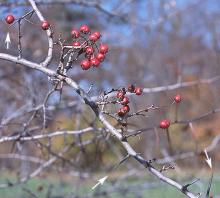Crataegus crus-galli
Common name:
Cockspur Hawthorn
Pronunciation:
kra-TEE-gus kroos-GA-lee
Family:
Rosaceae
Genus:
Type:
Broadleaf
Native to (or naturalized in) Oregon:
No
- Deciduous tree, 20-30 ft (6-9 m) tall, slightly greater spread, broad-rounded, branches often horizontal, wide-spreading, dense; thorns, stout, 3-8cm at first, later to 15 cm and branching. Leaves alternate, simple, 2.5-10 cm long and 1-3 cm wide, obovate, margin sharply serrate above the entire base, dark glossy green, glabrous (without hairs) above and below, orange-red to purplish in fall. Flowers white, 1.5 cm wide, 10 stamens, anthers pink, 2 styles, in flat clusters, disagreeable odor; blooms late. Fruit rounded or oblong, about 1 cm wide, deep red, usually contains 2 nutlets, persisting into late fall.
- Sun, not to fussy about soil type if well drained. Resistant to hawthorn rust. Tolerates city life
- Hardy to USDA Zone 4 and even protected locations in Zone 3 (Snyder, 2000). Native from Quebec to North Carolina and west into Minnesota, Kansas, and eastern Texas. A few selections available in the nursery trade, probably the most common is the thornless form, C. crus-galli var. inermis; the term inermis means unarmed, i.e., without thorns.
- crus-galli: crus, resembling a leg; galli, chicken; resembling a chicken leg, a reference to the thorns which may bring to mind the spur on a chicken's leg, hence Cockspur Hawthorn.
- Wichita, Kansas: Botanica








